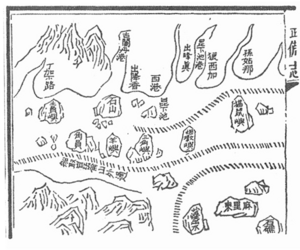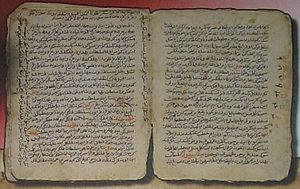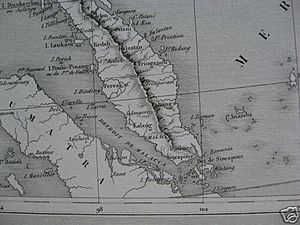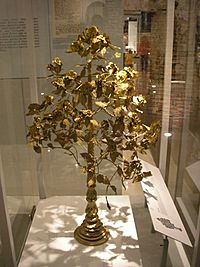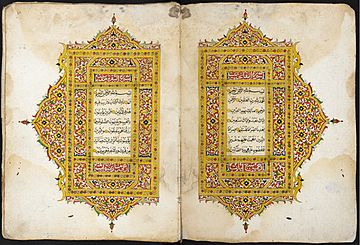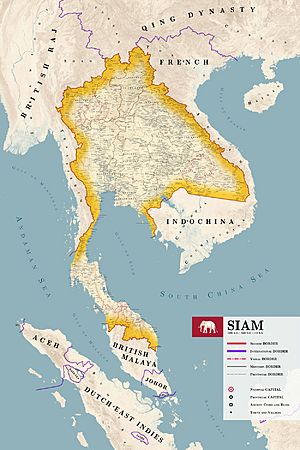Patani Kingdom facts for kids
Quick facts for kids
Sultanate of Patani
كسلطانن ڤطاني
Kesultanan Pattani |
|||||||||||
|---|---|---|---|---|---|---|---|---|---|---|---|
| 1457?–1902 | |||||||||||
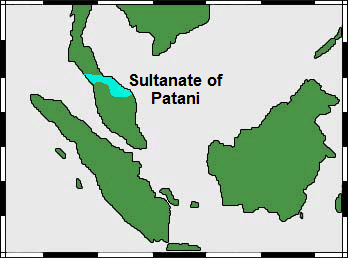
Map of the Sultanate of Patani
|
|||||||||||
| Capital | Pattani | ||||||||||
| Common languages | Malay language (Classical Malay; court language Kelantan-Pattani Malay; spoken daily language) |
||||||||||
| Religion | Sunni Islam | ||||||||||
| Government | Monarchy | ||||||||||
| Historical era | Middle Ages | ||||||||||
|
• Established
|
1457? | ||||||||||
|
• Conquest by Siam in 1786, later followed by annexation
|
1902 | ||||||||||
|
|||||||||||
| Today part of | Thailand Malaysia |
||||||||||
Patani, also known as the Sultanate of Patani, was an important Malay sultanate. It was located in a historical area called the Pattani Region. This region is now part of modern Thailand, including the provinces of Pattani, Yala, and Narathiwat. It also included a small part of the northern Malaysian state of Kelantan.
Patani had a "golden age" when four queens ruled one after another. This period started in 1584 with Raja Hijau (the Green Queen). She was followed by Raja Biru (the Blue Queen), Raja Ungu (the Purple Queen), and Raja Kuning (the Yellow Queen). During this time, Patani became very strong in its economy and military. It even fought off four major attacks from Siam (now Thailand). The kingdom started to decline in the late 1600s. Siam invaded Patani in 1786 and eventually took full control in 1902.
Contents
Early Kingdoms in Patani
Long before Patani, there was an old kingdom called Langkasuka in this area. It was a Hindu-Buddhist kingdom, founded as early as the 2nd century CE. Many Chinese travelers wrote about Langkasuka, including the Buddhist monk I Ching.
Langkasuka was a busy trading stop for ships. Traders from China, India, and local areas used it. It was most successful in the 6th and 7th centuries. After that, it became less important as a trade center. This might have been because the waterway connecting it to the sea became filled with mud.
The ruins believed to be ancient Langkasuka are found in Yarang. This place is about 15 kilometers from the sea and the modern city of Pattani. We don't know exactly how Langkasuka changed into Patani. Some stories say that Kota Mahligai was the kingdom just before Patani. Its ruler might have founded Patani between 1350 and 1450.
The Patani region was under Thai control for some time. In the 14th century, King Ram Khamhaeng the Great of Sukhothai ruled over nearby areas. Later, the Thai Ayutthaya kingdom also took control of this region. They allowed smaller states like Patani to govern themselves. These states promised loyalty to the king of Ayutthaya.
How Patani Got Its Name
There are two main stories about how Patani got its name.
The Mouse-Deer Story
One popular story says the name Patani means "this beach" (pata ni in the local Malay language). In this tale, a ruler was hunting and saw a small, beautiful white mouse-deer. It was as big as a goat and suddenly disappeared. The ruler asked his men where it went, and they replied, "Pata ni lah!" (Meaning "This beach!"). The ruler then ordered a town to be built where the mouse-deer vanished. The town was named after "this beach."
The Fisherman Story
Another story says the Patani kingdom was founded in the 14th century. It tells of a fisherman named Pak Tani (Father Tani). A king from inland sent him to find a good place for a settlement on the coast. Pak Tani set up a successful fishing spot, and other people came to join him. The town grew into a busy trading center and kept his name. However, old historical books like the Hikayat Patani say this story is not true. They claim the kingdom was founded by a Sultan.
Early Days of Patani
Patani was likely founded between 1350 and 1450. Its early history before 1500 is not very clear. One old Malay book, the Sejarah Melayu, says a Siamese prince named Chau Sri Wangsa founded Patani. He became a Muslim and took the name Sri Sultan Ahmad Shah.
Patani may have become a Muslim kingdom around the mid-15th century. One story says a Muslim scholar named Sa'id healed the king of a skin disease. After this, the king agreed to become a Muslim and took the name Sultan Ismail Shah. All his officials also converted. However, some people in the area might have become Muslim even before this. Traders from other Muslim areas had contact with Patani.
Patani became more important after Malacca was captured by the Portuguese in 1511. Many Muslim traders then looked for other ports to trade from. By the 1540s, about 300 Portuguese traders had settled in Patani.
Sultan Ismail Shah was followed by Sultan Mudhaffar Shah. In the 16th century, Burma attacked Ayutthaya. Sultan Mudhaffar Shah helped the Burmese attack Ayutthaya in 1563. But he died suddenly in 1564 on his way back to Patani. His brother, Sultan Manzur Shah, then became the ruler.
After Sultan Manzur Shah died, Patani had a period of trouble. Two rulers were killed by their own relatives in fights for power.
The Four Queens of Patani
Raja Hijau: Patani's Golden Age
Raja Hijau (the Green Queen) became queen in 1584. She was the first queen of Patani. She took the throne because there were no male heirs left after the earlier troubles. Raja Hijau accepted the authority of Siam. She also made sure Patani had enough water by digging a channel and damming a river.
Raja Hijau ruled for 32 years. She brought a lot of peace and stability to Patani. During her rule, trade with other countries grew, and Patani became very rich. It also became a center for art and culture. People made beautiful music, dances, plays, and handicrafts. An English visitor in 1612-1613 said the dances in Patani were the best he had seen.
Patani as a Trade Hub
Chinese merchants were very important in making Patani a major trade center. Traders from China, Malay, Siam, Persia, India, and Arabia all came here. Later, traders from Portugal (1516), Japan (1592), the Netherlands (1602), and England (1612) also joined them. Many Chinese people moved to Patani. A Dutch report from 1603 said there might have been as many Chinese people as native Malays in Patani. They were responsible for most of the business.
The Dutch East India Company (VOC) and the English East India Company set up warehouses in Patani. They traded a lot. Patani was seen by European traders as a way to reach the Chinese market. After 1620, the Dutch and English left, but Chinese, Japanese, and Portuguese traders continued to do good business for most of the 17th century.
The Blue and Purple Queens
Raja Hijau died in 1616. Her sister, Raja Biru (the Blue Queen), became queen. She was about 50 years old. Raja Biru convinced the Kelantan Sultanate to join Patani.
After Raja Biru died in 1624, her younger sister, Raja Ungu (the Purple Queen), took over. Raja Ungu was more against Siam. She stopped sending the Bunga mas tribute to Siam. She also made an alliance with Johor. She married her daughter (who later became Raja Kuning) to the ruler of Johor. This made Siam angry, and they attacked Patani in 1633–1634. However, Siam could not capture Patani.
The Yellow Queen and Patani's Decline
Raja Ungu died in 1634. Her daughter, Raja Kuning (the Yellow Queen), became the last of the four queens to rule Patani. The war with Siam had caused a lot of suffering and hurt Patani's trade. So, Raja Kuning tried to make peace with Siam. In 1641, Raja Kuning visited the Ayutthaya court to improve relations.
By this time, the queen's power had lessened. She did not have much political power. In 1646, Patani joined other states in a rebellion against Ayutthaya. But Ayutthaya later put down the rebellion.
Some records say Raja Kuning was removed from power in 1651. The Raja of Kelantan then put his son on the throne of Patani. After this, Patani had a period of political trouble for about 50 years. Foreign merchants stopped trading with Patani. By the end of the 17th century, Chinese records described Patani as having few people and being a wild place.
Siam Takes Control
In the 18th century, Ayutthaya faced another invasion from Burma. The city of Ayutthaya was captured and destroyed in 1767. Siam was in chaos, and Patani declared itself fully independent.
King Taksin later defeated the Burmese and brought Siam back together. His successor, King Rama I, started the Chakri dynasty. In 1786, Siam sent an army to make Patani submit again. Patani was easily defeated and became a state that paid tribute to Siam. The city of Patani was destroyed, and a new town was built nearby.
Patani under Bangkok's Rule
Patani tried to rebel several times. Because of this, Bangkok (the new capital of Siam) divided Patani into seven smaller states in the early 1800s. Britain recognized Siam's ownership of Patani in a treaty in 1826.
The throne of Patani was empty for a few decades. Then, in 1842, a member of the Kelantan royal family became the ruler. He ruled Patani, but Patani still recognized Siam's authority and sent the bunga mas tribute. In 1902, Siam wanted to have full control of Patani. They arrested and removed the last ruler of Patani because he would not agree to Siam's changes. This ended Patani as an independent state.
See also
 In Spanish: Reino de Patani para niños
In Spanish: Reino de Patani para niños
- Kingdom of Reman
- Pattani Province
- Pattani (region)
- South Thailand insurgency
- Yawi language
- List of Sunni Muslim dynasties


